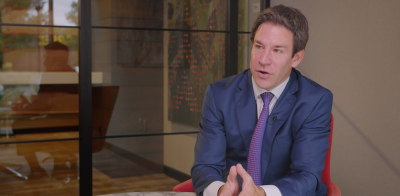So here we are, six months into the year with the Agg down—10.35% (more than three times the losses of all of 1994) and the S&P 500 down -20%. The hangover from 13 years of outrageous financial asset returns relative to the real economy and labor has now exceeded the clinical definition of a migraine. 60/40 portfolios are down around -16% YTD. Strategies that protect capital and grind out a consistent return should be chased like an oasis in the desert!
- Fortunately, in a challenging environment for markets, a select group of alternative strategies are still in positive territory for the year: Senior Secured CRE Debt and Low Beta/Low Duration Multi-Strategy.
- The keys to these strategies’ successes so far this year has been either high levels of market and economic resilience and floating rate income (CRE debt—Don’t Fight the Fed, High Five the Fed) or the ability to monetize heightened levels of market volatility (Multi-Strategy).
- Unfortunately for broader markets, many of the themes we have discussed this year, most notably the eventual tightening of monetary policy and the decline of money supply growth by the Fed (tightening cycles never go well) have negatively impacted equities and bond in Q2 and for the year.
- Despite the substantial losses so far this year, it is still very naïve to conclude the current struggle for equities and bonds will be over anytime soon: For the following reasons:
- Decline in money supply growth: Despite the Fed only reducing their close-to-$9 trillion balance sheet by a whopping $50–$75 billion, money supply growth has already declined from its peak in March. If the Fed actually moves forward with reducing the balance sheet by $47.5 billion in July followed by $95 billion/month thereafter, it is almost a certainty that money supply will struggle to grow at all, which will negatively impact market liquidity.
- Continued inflation: Excess demand and constrained supply exacerbated by the Russian invasion of Ukraine and China’s reticence to abandon their zero-Covid policy continue to drive inflationary pressure higher than recent expectations, which could place more political pressure on the Fed to raise rates even more aggressively than they have promised.
- Recession risk ahead: Recession risk has gone up substantially the past six to eight weeks as the U.S. consumer struggles to single-handedly keep the global economy moving in the right direction. With Germany’s manufacturing economy screeching to a halt due to high energy prices, China still not restimulating their economy and corporate America getting more conservative with their investment plans, the burden on the U.S. consumer continues to grow. If the U.S. economy contracts over the next six to 12 months, clearly, forward earnings estimates will come down and much of the multiple compression experienced so far for equities based on strong 2022 and 2023 earnings growth will turn out to be a pyrrhic dream.
- Many of the powerful factors other than money supply growth that have driven financial asset returns for decades are now going the other way:
- The peace dividend after the Cold War may soon turn into a rearmament drag as western democracies arm up for prolonged confrontation with Russia and eventually China.
- Globalization has rapidly turned into deglobalization for security, economic and political reasons.
- Labor’s share of national income to the benefit of capital could continue to mean revert due to a scarcity of workers.
- Corporate margins have undoubtedly peaked and have quite a way to fall due to various frictions associated with the previous three points.
- The 40 years secular decline in interest rates that mathematically justified higher and higher equity valuations could at least stay on a several-year hiatus.
- Despite historic losses in fixed income, there is still a reasonable probability that yields could continue to march higher as inflation simmers at 40-year peak levels. After all, the 10-year Treasury yield has risen only by 158 bps this year, despite inflation stuck at almost unimaginably high levels as recently as six months ago. If we had assembled an esteemed panel of market experts five years ago and asked how high 10-year Treasury yields would be if CPI came in north of 8% for three months in a row, we’re fairly certain that no one would have guessed a paltry 3.08%. Everyone present would have chuckled that 8%+ CPI numbers were not possible due to demographics, excess savings, technology, globalization, etc.—but here we are.
After being scolded for such a deep level of naïveté at considering such an outcome, answers to that question would certainly have been much higher than 3% and change since the last time inflation was so high, the 10-year traded at yields north of 8%. Be careful averaging down into duration especially since most investors still arguably have way too much duration already in an environment like this.
The one conceivable environment where one could conclude that yields have already peaked is if the U.S. economy is on the brink of entering a deep recession. So yes, no more duration pain for the 40 (fixed income), but an immense amount of pain in store for the 60 (equities). We’re not quite sure how that would be a victory for most investors. Lastly, if yields have indeed peaked, that may be the most tragic outcome of all for fixed income investors since there clearly is still not enough income in high quality fixed income markets to achieve investors asset allocation goals.
- We are collectively very excited about some of the opportunities present amidst this challenging economic and market environment:
- Senior Secured Commercial Real Estate Debt: There are now several tailwinds in place relative to even eight weeks ago.
We’re happily “High Fiving the Fed” in primarily floating rate exposure as interest rates move higher at a much faster rate than anticipated coming into the year. High front end rates = more income opportunity.
Since spreads and yields have moved higher in tradable securities, spreads in Private Commercial Loans have finally widened the past eight weeks. Wider lending spreads = more income opportunity.
Locally, the CMBS market has ground to a halt, banks are going from extra cautious to hyper cautious, and many private lenders are temporarily tapped out in terms of lending capability. Thus, we have a window over the summer where we can lend to trophy properties in great locations at higher spreads and lower LTVs.
The only caveat to the previous three statements is that acquisition and financing activity has slowed down significantly relatively early this year, which means there could also be fewer opportunities to put capital to work.
- The Multi-Strategy Platform: Short Mortgage Basis, Long Value/Short Growth Factor Exposures and Short Back end of yield curve positions have worked out extremely well relative to expectations in a relatively short period of time, and may be subject to trimming.
In terms of new exposures, investors may consider:
- CLOs where yields for BB Cash Flows are approaching 12%, which is pretty high relative to just about everything else out there. Fully floating rate, low risk of loss, multiyear return potential of north of 10%…what’s not to like? Well, there certainly could be more mark to market downside in the event of a recession, but sooner or later you have to start legging into cheap cash flows in a market dislocation of this magnitude.
- Interest Only Cash Flows back by residential mortgages. The thesis is fairly simple—now that rates have skyrocketed, refinance risk has plummeted. Almost more importantly, the probability of further meteoric home price gains has collapsed and the probability of declining prices has increased substantially, now that mortgage affordability has dropped to levels last seen in the pre-GFC housing bubble. High home prices typically drive more refi activity and lower home prices drive slower activity.
- One of the key attributes of both of these strategies is that nothing needs to happen to generate an above target return. We can collect the cheap cash flows for our clients and ride out some mark to market volatility. In the case of CLOs, if the Fed can thread the needle and the U.S. economy avoids a recession, there is upside capture potential as well. In the case of IO cash flows, if the economy and home prices deteriorate meaningfully, total return potential could actually improve, and refinance activity relative to interest rates declines.
- We also continue to evaluate volatility strategies that can protect the portfolio from further market declines. Since implied volatility is relatively low given actual realized market volatility and market participants are not bidding up puts any higher than calls right now, we may have an opportunity to buy cheap protection from further market declines.
- Business Development Companies: Lastly, when one focuses on listed BDCs, the yields and and recently discounts to NAV have only grown as recession risk increases.
In the meanwhile, opportunity arises for one to “high five the Fed” as rates go higher and access favorable yield.
Assets trading at a discount to NAV also provide positive convexity to an improving market environment and lower risk of loss in the event of a recession.
Unfortunately, the economic and market environment remain tricky to say the least. Fight inertia and take advantage of alternative strategies that can potentially better navigate an environment remarkably similar to the dotcom bubble collapse with some 1970s style inflation thrown in to drive the galactic mean reversion between financial assets, the real economy and labor…the time for alts is now.



